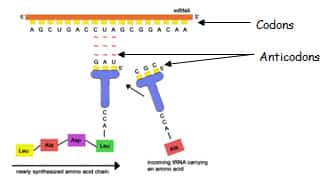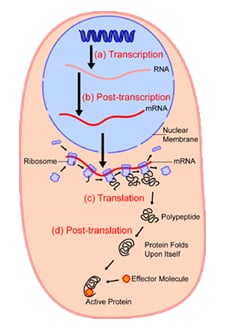DNA:
DNA is the genetic information or blueprint of who and what we are, and how we operate. This genetic information is devoted to the synthesis of proteins, which are essential to our body. Proteins are created from templates of information called genes in our DNA.
The Code:
– DNA molecules are long polymers of nucleotides
– the sequence the nucleotides is used to select specific amino acids
– the sequence of nucleotides will determine the types and sequence of amino acids in a protein
mRNA:
– DNA is found in the nucleus, because of their large size, DNA molecules are unable to leave the nucleus
– protein synthesis occurs in the cytoplasm, if a protein is to be synthesized the genetic information in the nucleus must be able to leave the nucleus
– a copy of a single gene called mRNA (messenger ribonucleic acid) is made
– mRNA is much smaller than a DNA molecule because it is only one gene in length
– because of it’s small size mRNA is able to take the genetic information out of the nucleus and into the cytoplasm
Transcription:
The genes on DNA molecule are transcribed (copied) into molecules of mRNA.
If the code of DNA looks like this : G-G-C-A-T-T
Then the mRNA would look like this: C-C-G-U-A-A (uracil replaces thymine)
With the genetic information responsible for creating substances now available on the mRNA strand, the mRNA moves out of the nucleus and away from the DNA towards the ribosomes.
mRNA and tRNA:
mRNA takes the genetic information to the ribosomes, the sites of protein synthesis. At the ribosome, the mRNA strand is translated by molecules of tRNA. tRNA molecules “read” (translate) the mRNA sequence, 3 nucleotides at a time. The code in a mRNA molecule are referred to as codons.
Each tRNA molecule contains 3 nucleotides, called an anticodon, which compliments the codon nucleotides on the mRNA strand. These in turn have the amino acid sequence to successfully code for a particular amino acid.
Attached to each tRNA molecule are specific amino acids. As they translate the mRNA sequence, the proper amino acids for a particular protein are being brought to the ribosome.
Amino acids are attached together at the ribosome to form a polypeptide chain which will go on to form a protein molecule.
Ribosomes and Rough Endoplasmic Reticulum (RER):
Ribosomes are the site of protein synthesis, they are found floating freely in the cytoplasm and on the outer surface of the endoplasmic reticulum (RER).
Proteins to be used by the cell are synthesized on the free floating ribosomes.
Proteins to be released by the cell (ex. Hormones, enzymes) are synthesized at the RER because the RER will transport proteins to the Golgi apparatus by way of a vesicle.
The Golgi Apparatus:
The Golgi apparatus processes polypetptide molecules to form proteins. The finished products are ‘pinched off’ the Golgi apparatus, and are transported by a vesicle to the cell membrane. When this vesicle reaches the cell membrane, it binds to a receptor on the surface and excretes the protein, where it can then undergo its function.



